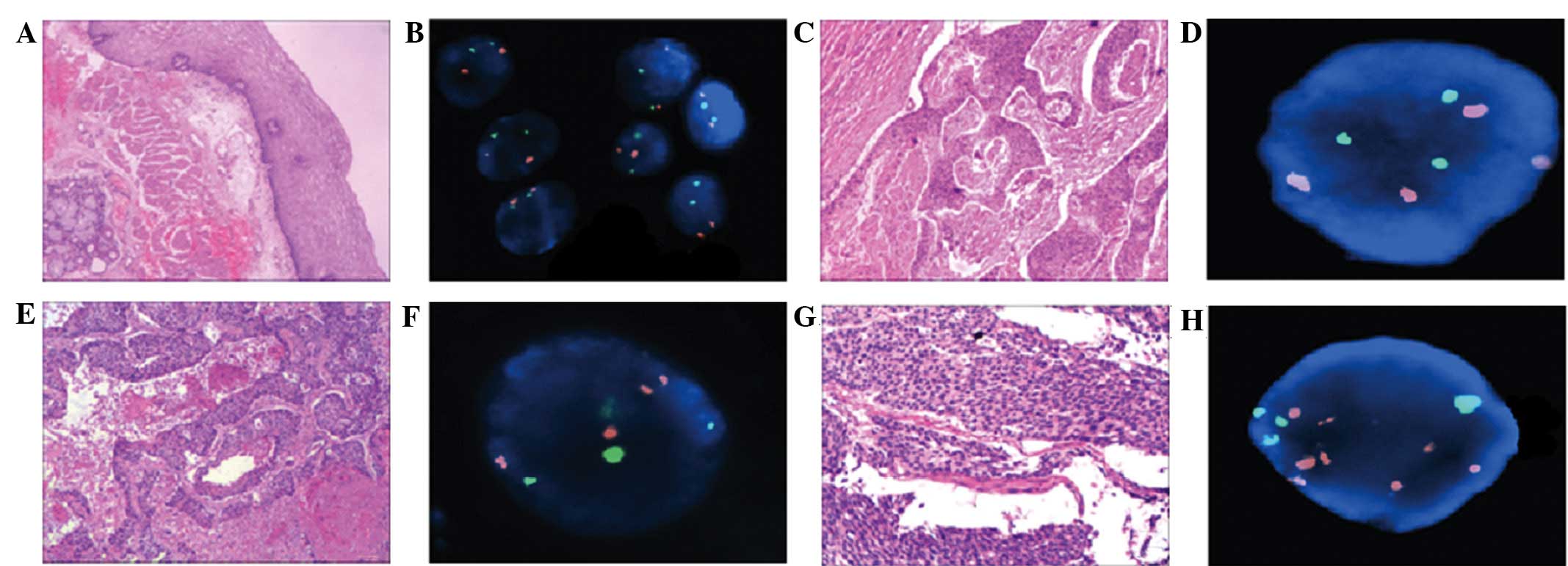|
1
|
Parkin DM: Global cancer statistics in the
year 2000. Lancet Oncol. 2:533–543. 2001. View Article : Google Scholar : PubMed/NCBI
|
|
2
|
Lu XM, Zhang YM, Lin RY, Arzi G, Wang X,
Zhang YL, Zhang Y, Wang Y and Wen H: Relationship between genetic
polymorphisms of metabolizing enzymes CYP2E1, GSTM1 and Kazakh's
Esophageal squamous cell cancer (ESCC) in Xinjiang, China. World J
Gastroenterol. 11:3651–3654. 2005. View Article : Google Scholar : PubMed/NCBI
|
|
3
|
Krasna MJ: Multimodality therapy for
esophageal cancer. Oncology (Williston Park). 24:1134–1138.
2010.PubMed/NCBI
|
|
4
|
Odze RD: Barrett esophagus: Histology and
pathology for the clinician. Nat Rev Gastroenterol Hepatol.
6:478–490. 2009. View Article : Google Scholar : PubMed/NCBI
|
|
5
|
Yerian L: Histology of metaplasia and
dysplasia in Barrett's esophagus. Surg Oncol Clin N Am. 18:411–422.
2009. View Article : Google Scholar : PubMed/NCBI
|
|
6
|
Papanicolaou GN: Criteria of malignancy.
Atlas of Exfoliative Cytology. Harvard University Press.
(Cambridge, MA). 13–21. 1954.
|
|
7
|
Awut I, Niyaz M, Huizhong X, Biekemitoufu
H, Yan ZH, Zhu Z, Sheyhedin I, Changmin Z, Wei Z and Hao W: Genetic
diagnosis of patients with esophageal cancer using FISH. Oncol
Lett. 1:809–814. 2010.PubMed/NCBI
|
|
8
|
Niyaz M, Turghun A, Ping ZH, Zhu Z,
Sheyhedin I, Ren C and Awut I: TP53 gene deletion in esophageal
cancer tissues of patients and its clinical significance. Mol Med
Rep. 7:122–126. 2013.PubMed/NCBI
|
|
9
|
Rajagopalan H and Lengauer C: Aneuploidy
and cancer. Nature. 432:338–341. 2004. View Article : Google Scholar : PubMed/NCBI
|
|
10
|
Chao WR, Lee MY, Lin WL, Koo CL, Sheu GT
and Han CP: Assessing the HER2 status in mucinous epithelial
ovarian cancer on the basis of the 2013 ASCO/CAP guideline update.
Am J Surg Pathol. 38:1227–1234. 2014. View Article : Google Scholar : PubMed/NCBI
|
|
11
|
Halling KC and Kipp BR: Fluorescence in
situ hybridization in diagnostic cytology. Hum Pathol.
38:1137–1144. 2007. View Article : Google Scholar : PubMed/NCBI
|
|
12
|
Tafe LJ, Allen SF, Steinmetz HB, Dokus BA,
Cook LJ, Marotti JD and Tsongalis GJ: Automated processing of
fluorescence in-situ hybridization slides for HER2 testing in
breast and gastro-esophageal carcinomas. Exp Mol Pathol.
97:116–119. 2014. View Article : Google Scholar : PubMed/NCBI
|
|
13
|
Prins MJ, Ruurda JP, van Diest PJ, van
Hillegersberg R and ten Kate FJ: Evaluation of the HER2
amplification status in oesophageal adenocarcinoma by conventional
and automated FISH: A tissue microarray study. J Clin Pathol.
67:26–32. 2014. View Article : Google Scholar : PubMed/NCBI
|
|
14
|
Gordon MA, Gundacker HM, Benedetti J,
Macdonald JS, Baranda JC, Levin WJ, Blanke CD, Elatre W, Weng P,
Zhou JY, et al: Assessment of HER2 gene amplification in
adenocarcinomas of the stomach or gastroesophageal junction in the
INT-0116/SWOG9008 clinical trial. Ann Oncol. 24:1754–1761. 2013.
View Article : Google Scholar : PubMed/NCBI
|
|
15
|
Yoshizawa A, Sumiyoshi S, Sonobe M,
Kobayashi M, Uehara T, Fujimoto M, Tsuruyama T, Date H and Haga H:
HER2 status in lung adenocarcinoma: A comparison of
immunohistochemistry, fluorescence in situ hybridization (FISH),
dual-ISH, and gene mutations. Lung Cancer. 85:373–378. 2014.
View Article : Google Scholar : PubMed/NCBI
|
|
16
|
Awut I, Niyaz M, Biekemitoufu H, Zhang Z,
Sheyhedin I and Hao W: Molecular pathological diagnosis for early
esophageal cancer in Kazakh patients. Oncol Lett. 3:549–553.
2012.PubMed/NCBI
|
|
17
|
Nakamura H, Saji H, Idiris A, Kawasaki N,
Hosaka M, Ogata A, Saijo T and Kato H: Chromosomal instability
detected by fluorescence in situ hybridization in surgical
specimens of non-small cell lung cancer is associated with poor
survival. Clin Cancer Res. 9:2294–2299. 2003.PubMed/NCBI
|
|
18
|
Rice TW, Blackstone EH and Rusch VW: 7th
edition of the AJCC Cancer Staging Manual: esophagus and
esophagogastric junction. Ann Surg Oncol. 17:1721–1724. 2010.
View Article : Google Scholar : PubMed/NCBI
|
|
19
|
Li C, Ba J, Hao X, Zhang S, Hu Y, Zhang X,
Yuan W, Hu L, Cheng T, Zetterberg A, et al: Multi-gene fluorescence
in situ hybridization to detect cell cycle gene copy number
aberrations in young breast cancer patients. Cell Cycle.
13:1299–1305. 2014. View
Article : Google Scholar : PubMed/NCBI
|
|
20
|
Nakamura H, Idiris A, Kawasaki N, Taguchi
M, Ohira T and Kato H: Quantitative detection of lung cancer cells
by fluorescence in situ hybridization: Comparison with conventional
cytology. Chest. 128:906–911. 2005. View Article : Google Scholar : PubMed/NCBI
|
|
21
|
Fiegl M, Massoner A, Haun M, Sturm W,
Kaufmann H, Hack R, Krugmann J, Fritzer-Szekeres M, Grünewald K and
Gastl G: Sensitive detection of tumour cells in effusions by
combining cytology and fluorescence in situ hybridisation (FISH).
Br J Cancer. 91:558–563. 2004. View Article : Google Scholar : PubMed/NCBI
|
|
22
|
Fritcher EG, Brankley SM, Kipp BR, Voss
JS, Campion MB, Morrison LE, Legator MS, Lutzke LS, Wang KK, Sebo
TJ and Halling KC: A comparison of conventional cytology, DNA
ploidy analysis, and fluorescence in situ hybridization for the
detection of dysplasia and adenocarcinoma in patients with
Barrett's esophagus. Hum Pathol. 39:1128–1135. 2008. View Article : Google Scholar : PubMed/NCBI
|
|
23
|
Bahmanyar S and Ye W: Dietary patterns and
risk of squamous-cell carcinoma and adenocarcinoma of the esophagus
and adenocarcinoma of the gastric cardia: A population-based
case-control study in Sweden. Nutr Cancer. 54:171–178. 2006.
View Article : Google Scholar : PubMed/NCBI
|
|
24
|
Morita M, Kumashiro R, Kubo N, Nakashima
Y, Yoshida R, Yoshinaga K, Saeki H, Emi Y, Kakeji Y, Sakaguchi Y,
et al: Alcohol drinking, cigarette smoking, and the development of
squamous cell carcinoma of the esophegus: Epidemiology, clinical
findings, and prevention. Int J Clin Oncol. 15:126–134. 2010.
View Article : Google Scholar : PubMed/NCBI
|















